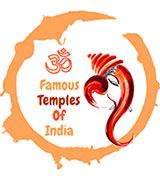Nanjundeshwara Temple Mysore | Sri Srikanteshwara Temple
The Nanjundeshwara Temple also called with Sri Srikanteshwara Temple is located in Mysore, Karnataka. The main diety in this temple is Lord Shiva, the word “Nanjundeshwara” means “The Lord who consumed poison,” this context refers to the mythology of Samudra Manthan, where Lord Shiva swallowed the poison during the churning of the ocean to save the world. The temple is renowned for its rich history, beautiful architecture, and religious importance.
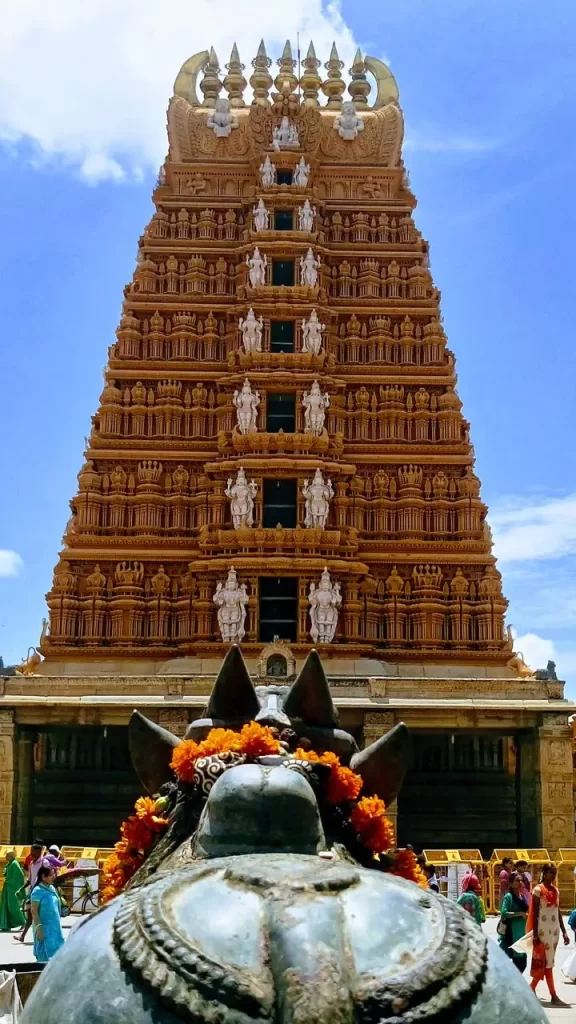
Contents
History of Nanjundeshwara Temple:
Early Origins: The word Nanjundeshwara is closly tied to Mythology related to churning of the ocean. Whereas, the temple origins roots to the Ganga dynasty (period between 9th-10th centuries AD), who likely built a smaller shrine initially. Some local legends state that the first Linga installation is done by Sage Gauthama.
Over the centuries, the temple saw significant contributions and expansions from various ruling dynasties:
Cholas (11th century AD): During this period, temple saw architectural additions along with the construction of the Garba Griha (sanctum sanctorum).
Hoysalas (13th century AD): They added the anterior Mandapam (hall for devotees). Pillars within the Nanjundeshwara Temple, such as the dancing Ganapati statue, are attributed to this period.
Vijayanagara Empire: During this era, the Parvati and Narayana shrines were added, and the main stucco Shikara (tower above the sanctum) was built.
Wodeyars of Mysore (17th-18th centuries): They were known for their patronage of art, culture, and religion and are credited with the temple’s present grandeur. Krishnaraja Wadiyar III’s queen, Devarajammanni, built the impressive nine-storied Gopuram (gateway tower) in 1849. The Wodeyars also made grants for renovations and gifted chariots and other valuables to the temple.
Tipu Sultan’s Connection: Interestingly, the temple also has a historical connection with the Muslim ruler Tipu Sultan. When his royal elephant suffered from an eye ailment, he is said to have prayed to Lord Nanjundeshwara. Upon the elephant’s recovery, Tipu Sultan, in gratitude, gifted an emerald green Lingam to the temple and referred to Lord Shiva as “Hakim Nanjunda” (healer).
Read More>> Mukteswar Temple Bhubaneswar
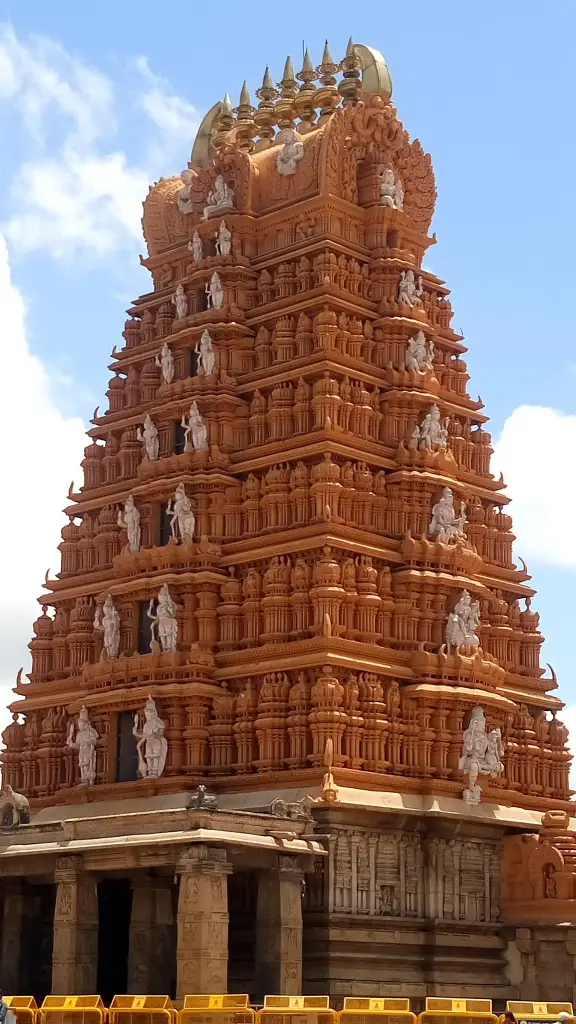
Legend of Nanjundeshwara Temple:
The roots of Nanjundeshwara Temple is steeped in captivating legends that explain the deity’s name and the sanctity of the place:
1. The Legend of Kshir Sagar Manthana (Churning of the Ocean):
- The most prominent legend is connected to the Samudra Manthana, a famous episode in Hindu mythology. When the forces of Devas (gods) and Asuras (demons) churned the cosmic ocean of milk to obtain the nectar of immortality (Amrita).
- To do this churning they used Mount Mandara as the churning rod and the serpent Vasuki as the rope. As they churned the ocean, various precious items and divine beings emerged, including Lakshmi, the goddess of wealth, and the Kalpavriksha, the wish-fulfilling tree, a deadly poison called Halahala emerged before the nectar.
- The poison was so potent that it threatened to destroy the entire universe. Lord Shiva, out of compassion, consumed this poison to save all beings. During this process lord shiva had pain in his throat. However, his consort, Goddess Parvati, pressed his throat tightly to prevent the poison from spreading into his body. As a result, the poison remained in his throat, turning it blue.
- Due to this act of drinking the “Nanju” (poison in Kannada), Lord Shiva came to be known as Nanjundeshwara – “the God who drank the poison.” He is also called Srikanteshwara – “the Lord with a beautiful throat” (referring to the blue hue). This legend also explains why Nanjangud is sometimes called “Garalapuri” (the abode of poison-drinker).
2. The Legend of the Asura Kesian:
- Another legend narrates the tale of a venomous Asura (demon) named Kesian who harassed the Devas.
- The Devas sought the protection of Lord Shiva, who instructed them to perform a Yagna (fire sacrifice) at the confluence of the Kapila, Koundini, and Manikarnika rivers.
- Shiva advised them to throw Kesian into the fire pit when he arrived. The Devas followed this advice, and when Kesian appeared, they pushed him into the fire.
- Lord Shiva manifested as Agni (fire) and destroyed the Asura. After defeating the poisonous Kesian, Shiva stayed in the area in the form of a Lingam and became known as Nanjundeshwara. This legend also links the name of the town, Nanjangud (“the abode of the god Nanjundeshwara”), to this event.
3. The Legend of Sage Parashurama:
- Sage Parashurama, an avatar of Lord Vishnu, is also associated with the Nanjundeshwara Temple.
- As penance for killing his mother, Renuka Devi (on his father’s orders), Parashurama sought to purify himself.
- Following the advice of Sage Narada, he came to Garalapuri (Nanjangud) and began meditating on Lord Nanjundeshwara.
- While clearing bushes with his axe (Parashu), he unintentionally struck a Shiva Lingam, causing it to bleed. Overwhelmed with guilt for causing injury to the Lord, Parashurama was about to end his life.
- Lord Shiva appeared before him, blessed him, and instructed him to apply wet mud from the area onto the Lingam. Miraculously, the bleeding stopped.
- Lord Shiva then advised Parashurama to build a Mantapa (pavilion) and consecrate the Shiva Lingam there, continuing his penance. It is believed that Parashurama built the original temple at this site. The confluence of the Kapila and Koundinya rivers nearby is also known as “Parashurama Kshetra.”
Read More>> Khajuraho Temple: Beyond the Erotic Sculptures
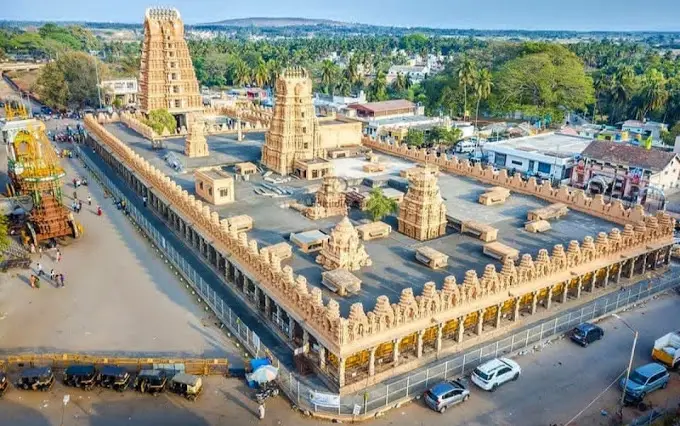
Significance of Sri Srikanteshwara Temple:
1. Religious and Mythological Importance:
- Dakshina Kashi: Nanjangud, the town where the temple is located, is revered as “Dakshina Kashi” (the Varanasi of the South). This highlights its sanctity and importance as a major Shaiva pilgrimage center in South India.
- Lord Shiva as the Healer: The primary deity, Lord Shiva, is worshipped here as Nanjundeshwara, meaning “the God who drank poison.” This refers to the legend of the Samudra Manthana, where Shiva consumed the deadly Halahala poison to save the universe. He is also known as Srikanteshwara, “the Lord with a beautiful throat” (due to the poison). Devotees believe that Lord Nanjundeshwara has the power to heal illnesses and grant well-being, earning him the title “Vaidya Nanjunda” (the physician Nanjunda).
- Papa Vinashini Kshetra: The region is historically known as Sri Garalapuri and is considered a “papa vinashini,” a place that eradicates sins. Taking a dip in the holy Kapila River and praying to Lord Srikanteshwara is believed to cleanse devotees of their wrongdoings and bestow divine blessings.
- Legends: The Nanjundeshwara Temple is associated with various significant legends, including:
- Lord Shiva vanquishing the demon Keshi in this place.
- Sage Parashurama installing a Shiva Lingam here as penance for beheading his mother and being relieved of his sin after praying to Lord Nanjundeshwara.
- Goddess Parvati’s visit and the origin of the name “Dakshina Manikarnika Ghat” for a part of the Kabini River.
- Connection to Devas and Sages: The Shiva Purana mentions that Lord Shiva manifested here at the request of the Devas (celestial beings) and Sage Narada, further emphasizing the place’s divine significance.
2. Historical Significance:
- Ancient Origins and Patronage: Sri Srikanteshwara Temple history spans centuries, with contributions from major dynasties like the Gangas, Cholas, Hoysalas, Vijayanagara Empire, and the Wodeyars of Mysore. This continuous patronage underscores its enduring religious and cultural importance.
- Tipu Sultan’s Devotion: The temple has a unique connection with the Muslim ruler Tipu Sultan, who, out of gratitude for the recovery of his elephant’s eyesight, gifted an emerald green Lingam to the temple and referred to Lord Shiva as “Hakim Nanjunda” (healer). This highlights the temple’s reputation for healing and its influence beyond religious boundaries.
3. Architectural Grandeur:
- Blend of Styles: The temple’s architecture showcases a beautiful amalgamation of Dravidian and Hoysala styles, reflecting the contributions of different eras.
- Impressive Gopuram: The nine-storied, 120-foot-tall Gopuram (gateway tower) built by the queen of Krishnaraja Wadiyar III is a magnificent structure adorned with intricate sculptures and carvings, symbolizing the temple’s artistic and religious significance.
- Numerous Shrines and Sculptures: The temple complex houses various shrines dedicated to other deities, along with exquisite stone and metal sculptures depicting mythological scenes and different forms of Lord Shiva.
4. Cultural and Social Importance:
- Pilgrimage Center: The Srikanteshwara Temple is a major pilgrimage site, attracting countless devotees from Karnataka and beyond seeking spiritual solace and blessings.
- Festivals and Rituals: The temple hosts vibrant festivals like the Dodda Jaathre (chariot festival), Chikka Jaathre, and Maha Shivaratri, which draw thousands of devotees and showcase the region’s rich cultural traditions.
- Community Hub: The Nanjundeshwara Temple has historically played a vital role in the local community, shaping its cultural heritage and serving as a center for religious discourses and Vedic studies.
Read More>> Lingaraj Temple: Odisha’s Architectural Marvel
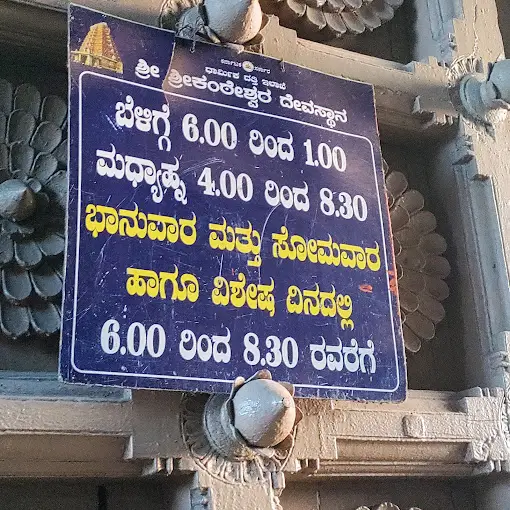
Nanjundeshwara Temple Timing:
Weekdays (Tuesday to Saturday): 6:00 AM to 1:00 PM and 4:00 PM to 8:30 PM
Sundays and Mondays: 6:00 AM to 8:30 PM
Special Days: On special days and during festivals, the timings might be subject to change due to special poojas and rituals. It’s always advisable to check with the temple authorities for specific timings during these occasions.
Abhishekam Timings (at Srikanteshwara Temple, Nanjangud):
Usha Kala Abhishekam: 6:30 AM
Pratha Kala Abhishekam: 9:00 AM
Sangama Kala Abhishekam: 11:00 AM
Madhyana Kala Abhishekam: 12:00 PM
Pradosha Kala Abhishekam: 6:30 PM
Ekanta Kala Abhishekam: 8:00 PM

Sri Srikanteshwara Temple Festivals:
1. Dodda Jaathre (Big Chariot Festival) / Panchamaha Rathotsava:
- This is the most significant and grand festival of the temple, held annually usually in March or April. The exact dates are determined based on the Hindu calendar. In 2025, the Dodda Jathre is scheduled for April 9th.
- It’s a ten-day festival that attracts thousands of devotees from all over.
- The highlight is the procession of five beautifully decorated chariots (rathas) carrying the idols of:
- Lord Nanjundeshwara (Sri Srikanteshwara)
- Goddess Parvati
- Lord Ganesha
- Lord Subramanya
- Lord Chandikeshwara
- Devotees enthusiastically pull these chariots along the main streets of Nanjangud (Ratha Beedi).
- During this festival, cultural programs and the illumination of Sri Srikanteshwara Temple add to the festive atmosphere.
- A colorful Theppotsava (floating festival) is also held in the Kapila River as part of the Dodda Jaathre, usually a couple of days after the chariot procession.
2. Chikka Jaathre (Small Chariot Festival):
- This festival is held annually, usually in the month of November or December.
- During this event, three chariots are taken out in procession. These typically include the chariots of Lord Srikanteshwara and two other deities.
3. Maha Shivaratri:
- This is a major festival dedicated to Lord Shiva, celebrated with great devotion and fervor. It usually falls in February or March. In 2025, Maha Shivaratri was celebrated on February 26th.
- Devotees observe a day-long fast, offer special prayers and rituals to Lord Shiva, and many stay awake throughout the night (Jagarane) in the temple.
- Sri Srikanteshwara Temple is specially decorated, and various religious and cultural programs are organized.
- Thousands of devotees visit Sri Srikanteshwara Temple on this auspicious occasion.
4. Sri Girija Kalyana:
- This festival celebrates the divine marriage of Lord Shiva and Goddess Parvati.
- It is usually held in the month of Ashada Masa (around July).
- The deities are beautifully adorned, and special rituals depicting their wedding are performed.
- A grand floating festival (Theppotsava) in the Kapila River is also part of this celebration for three evenings.
5. Skanda (Subramanya) Shashti:
- This festival is dedicated to Lord Subramanya (Kartikeya).
- A chariot procession of Lord Subramanya’s idol is held on this day.
6. Monthly Rathotsavas:
- Every full moon day, a grand chariot festival (Rathotsava) is held for Lord Srikanteshwara Swamy. Large numbers of people participate in pulling the chariot.
- Special Rathotsavas are also held on Ratha Saptami and Subbarayana Shashti.
7. Sri Srikanteshwara Jayanthi:
- On the occasion of Sri Srikanteshwara Jayanthi, a procession of eleven smaller chariots takes place.
8. Lakshadeepotsava:
- This festival of lights is celebrated during the Karthika Masa (October/November). Sri Srikanteshwara Temple is illuminated with numerous lamps, creating a beautiful spectacle.
Read More>> Mukteswar Temple Bhubaneswar
Places to visit near Nanjundeshwara Temple:
Within Nanjangud:
- Parashurama Kshetra: This is the confluence of the Kapila and Kaundinya rivers. It’s a significant spot where Sage Parashurama is said to have atoned for his sins.
- Sri Raghavendra Swamy Mutt (Preteeka Sanidhi): This Mutt houses a statue of Sri Raghavendra Swamy instead of the traditional Brindavana. It’s a revered place for devotees.
- Nanjangud Bridge (Oldest Bridge): Built in 1735, this is considered one of the oldest bridges in the region and offers a glimpse into the historical architecture.
- Other Temples in Nanjangud: You can explore other smaller temples like Sri Santana Venugopalaswamy Temple, Parashurama Temple, and Sri Ayyappa Swamy Temple.
Nearby Attractions (within approximately 1 hour’s drive):
- Mysore (around 23 km): A major cultural hub with numerous attractions:
- Mysore Palace: The magnificent palace of the Wadiyar dynasty, a must-visit for its Indo-Saracenic architecture.
- Chamundi Hills and Chamundeshwari Temple: A prominent pilgrimage site with panoramic views of Mysore city. You can drive up or climb the steps.
- Mysore Zoo (Sri Chamarajendra Zoological Gardens): One of the oldest and well-maintained zoos in India, housing a diverse range of animals.
- St. Philomena’s Church: A beautiful Catholic church with stunning Neo-Gothic architecture.
- Jaganmohan Palace and Art Gallery: Houses a significant collection of paintings and artifacts.
- Karanji Lake: A picturesque lake with a butterfly park and various bird species, ideal for nature lovers.
- Brindavan Gardens and Krishna Raja Sagara (KRS) Dam (around 48 km): Famous for its illuminated musical fountains in the evening.
- Mysore Rail Museum: Showcases the history of Indian Railways with vintage locomotives.
- Lingambudhi Lake: A serene lake offering a peaceful environment.
- Regional Museum of Natural History Mysore: Provides insights into the natural history of the region.
- Shuka Vana: A unique aviary with a vast collection of birds.
- Bonsai Garden: A beautiful garden showcasing miniature trees.
- Srirangapatna (around 38 km): A historically significant town that was the capital of Tipu Sultan:
- Ranganathaswamy Temple: An important Vishnu temple and one of the largest in Karnataka.
- Tipu Sultan’s Summer Palace (Daria Daulat Bagh): A historical monument showcasing Indo-Islamic architecture.
- Srirangapatna Fort: The historic fort with various points of interest.
- Gumbaz: The tomb of Tipu Sultan and his family.
- Sangam: The confluence of the Kaveri, Lokapavani, and Hemavati rivers.
- Ranganathittu Bird Sanctuary (around 39 km): A paradise for bird watchers, especially during the migratory season.
- Himavad Gopalaswamy Betta (around 57 km): A scenic hill station with a temple dedicated to Lord Krishna. It often gets covered in mist.
- Bandipur National Park (around 65 km): A renowned wildlife sanctuary and tiger reserve, offering opportunities for wildlife safaris.
- Talakadu (around 43 km): Known for its cluster of ancient temples, mostly buried in sand, on the banks of the Kaveri River.
- Somnathpur Temple (around 38 km): Famous for its well-preserved 13th-century Hoysala temple dedicated to Lord Chennakesava.

How to reach Nanjundeshwara Temple:
By Air:
- The nearest airport is Mysore Airport (MYQ), also known as Mandakalli Airport, located approximately 16 km from Nanjangud.
- From the Mysore Airport, you can hire a taxi or take a bus to reach Nanjangud. The journey by taxi takes around 30-45 minutes.
- Kempegowda International Airport Bengaluru (BLR) is a major international airport, about 165 km away. From Bengaluru, you can travel to Nanjangud by train, bus, or taxi.
By Train:
- The nearest railway station is Nanjangud Town (NTW), situated about 1 km from Sri Srikanteshwara Temple. Several trains connect Nanjangud to Mysore and other nearby cities.
- Mysore Junction (MYS) is a major railway station, approximately 23 km from Nanjangud. You can easily find trains from major cities like Bengaluru to Mysore. From Mysore Railway Station, you can take a local train or bus to Nanjangud. The train journey from Mysore to Nanjangud takes around 30-40 minutes.
By Road:
- Nanjangud is well-connected by road.
- Bus: Regular KSRTC (Karnataka State Road Transport Corporation) buses and private buses operate from Mysore to Nanjangud. The distance is about 23 km, and the bus journey takes approximately 35-45 minutes. Buses are available frequently from the Mysore Sub-urban Bus Stand. You can also find buses from Bengaluru and Chamarajanagar to Nanjangud.
- Taxi/Car: You can hire a taxi or drive your own car from Mysore (around 30 minutes) or Bengaluru (around 3-4 hours depending on traffic). The road from Mysore to Nanjangud is well-maintained.
